Inspection Pictures
New Construction
Inspecting new homes is a large and growing segment of the home inspection industry, and for good reason. In spite of County Code Enforcement inspections, deficiencies in new construction are surprisingly frequent. The average Code Enforcement Inspector has far less time to devote to an individual house as a professional Home Inspector does: they do not go on the roof to insure that the shingles and flashing were properly installed, nor do they go into the crawlspace or attic during their final inspection after the house is completed. It's important to note that a home inspection is not a code inspection. Home Inspectors look for construction concerns that do not conform to standard building practices, but will not cite specific code references when problems are found. Here are some pictures of problems that I found on new construction inspections.
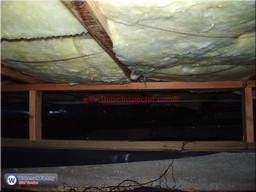 1. A support 'cripple stud' was removed during construction and should be replaced.
1. A support 'cripple stud' was removed during construction and should be replaced.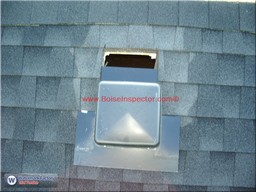 2. The attic vents on this house were never secured leaving holes in the roof.
2. The attic vents on this house were never secured leaving holes in the roof.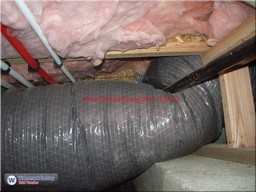 3. This is the main supply line for the Heat/Air system that has been pinched causing airflow to be greatly reduced by the location of the gas line.
3. This is the main supply line for the Heat/Air system that has been pinched causing airflow to be greatly reduced by the location of the gas line.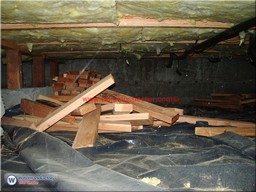 4. Construction debris under left under the house can attract termites.
4. Construction debris under left under the house can attract termites.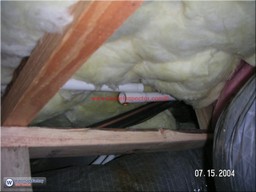 5. The condensate drain line for the Air Conditioning evaporative coil was never connected causing it to drain under the house.
5. The condensate drain line for the Air Conditioning evaporative coil was never connected causing it to drain under the house.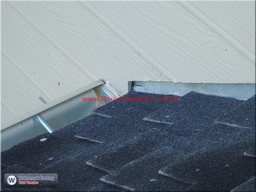 6. The 'kick out' flashing was not properly installed here which will allow water to run behind the siding.
6. The 'kick out' flashing was not properly installed here which will allow water to run behind the siding.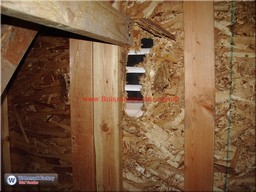 7. Ventilation in the attic has been greatly reduced due to the wood left in place behind the gable vent.
7. Ventilation in the attic has been greatly reduced due to the wood left in place behind the gable vent.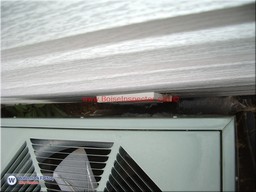 8. The air conditioning compressor was installed directly in front of the dryer vent. Lint from the dryer will clog the fins in the condensing coil which will make it less efficient.
8. The air conditioning compressor was installed directly in front of the dryer vent. Lint from the dryer will clog the fins in the condensing coil which will make it less efficient.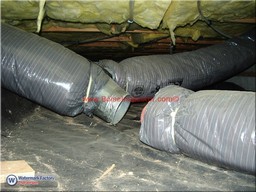 9. An Air conditioning supply line was disconnected under the house.
9. An Air conditioning supply line was disconnected under the house.
Used Houses
Here are some pictures of defects that I found on previously owned houses.
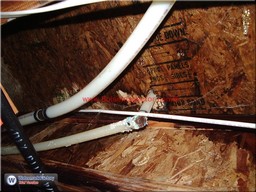 1. A slow leak under the house can go un-noticed for years and lead to expensive moisture damage
1. A slow leak under the house can go un-noticed for years and lead to expensive moisture damage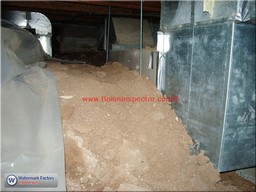 2. Dirt should never be piled against the furnace housing.
2. Dirt should never be piled against the furnace housing.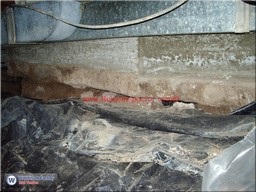 3. The foundation here has been greatly undermined
3. The foundation here has been greatly undermined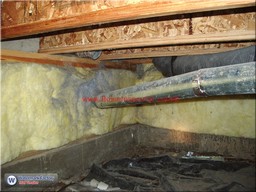 4. A disconnected dryer vent under a house will cause excessive humidity and can lead to mold growth
4. A disconnected dryer vent under a house will cause excessive humidity and can lead to mold growth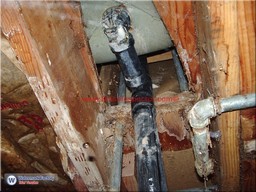 5. A leak and moisture damage under a bath tub
5. A leak and moisture damage under a bath tub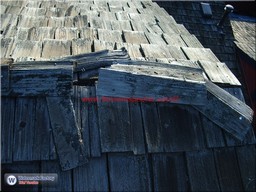 6. Deteriorated ridge cap
6. Deteriorated ridge cap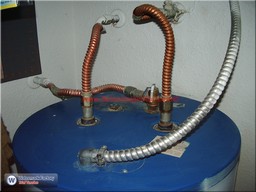 7. Improper pipe used on the Temperature Pressure Relief or TPR valve on the water heater. Flex pipe reduces water flow and can not be used.
7. Improper pipe used on the Temperature Pressure Relief or TPR valve on the water heater. Flex pipe reduces water flow and can not be used.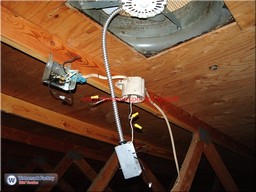 8. Electrical connections must be made inside of a sealed electrical box to contain any arching that may occur.
8. Electrical connections must be made inside of a sealed electrical box to contain any arching that may occur.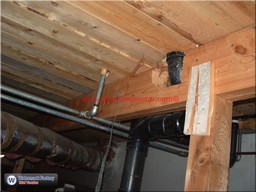 9. Notches in the floor framing can not exceed 1/6 the depth of the wood support.
9. Notches in the floor framing can not exceed 1/6 the depth of the wood support.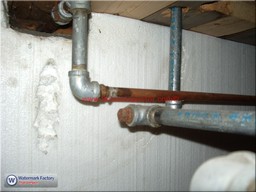 10. Copper and galvanized piping directly connected will result in leaks if not isolated by a brass fitting or a dielectric union
10. Copper and galvanized piping directly connected will result in leaks if not isolated by a brass fitting or a dielectric union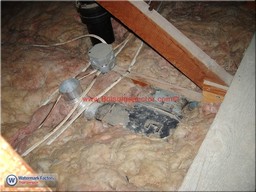 11. Exhaust fans must be vented to the exterior
11. Exhaust fans must be vented to the exterior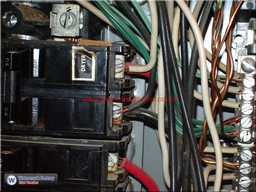 12. This circuit breaker was not designed to service two circuts
12. This circuit breaker was not designed to service two circuts 13. A disconnected furnace vent will allow carbon monoxide into the living space and is very dangerous
13. A disconnected furnace vent will allow carbon monoxide into the living space and is very dangerous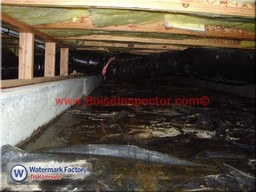 14. Water under the house indicates a serious drainage problem
14. Water under the house indicates a serious drainage problem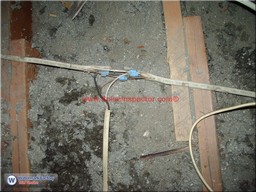 15. Electrical connections must be made inside of a sealed electrical box and with approved connectors to contain any arching that may occur.
15. Electrical connections must be made inside of a sealed electrical box and with approved connectors to contain any arching that may occur.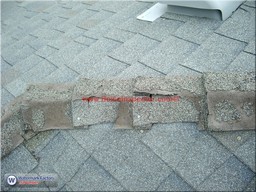 16. Deteriorated ridge cap
16. Deteriorated ridge cap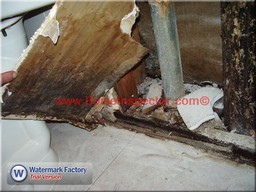 17. Mold growth in a bathroom wall caused by a plumbing leak
17. Mold growth in a bathroom wall caused by a plumbing leak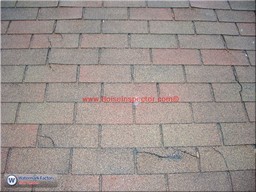 18. Roof shingles that are cracking prematurely and will need to be replaced soon
18. Roof shingles that are cracking prematurely and will need to be replaced soon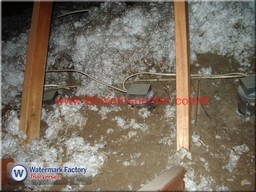 19. Not all 'can lights' can be covered with insulation. Covering non-rated fixtures can over heat the fixture and can lead to a fire
19. Not all 'can lights' can be covered with insulation. Covering non-rated fixtures can over heat the fixture and can lead to a fire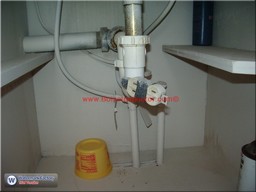 21. Electrical outlets must be installed inside of a sealed electrical box
21. Electrical outlets must be installed inside of a sealed electrical box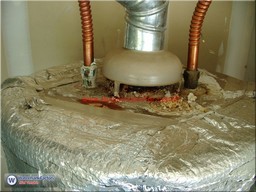 22. Leaking water heater
22. Leaking water heater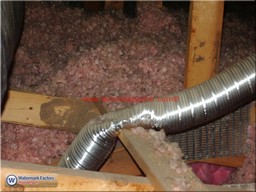 24. Crushed bathroom exhaust vent
24. Crushed bathroom exhaust vent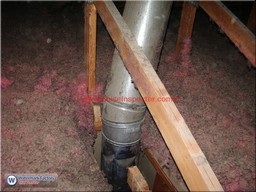 25. The bottom cord of this truss has been cut which is never allowed without the written approval of a structural engineer
25. The bottom cord of this truss has been cut which is never allowed without the written approval of a structural engineer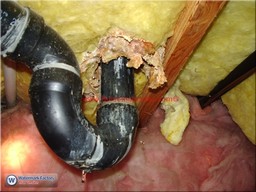 27. Leak under the bathroom
27. Leak under the bathroom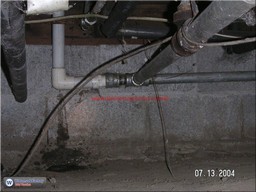 29. This is a drain line that not only leaks but the wrong type of pipe fittings were used. The bends in PVC pipe (used here) are too sharp, will lead to clogs and are difficult to run a snake through.
29. This is a drain line that not only leaks but the wrong type of pipe fittings were used. The bends in PVC pipe (used here) are too sharp, will lead to clogs and are difficult to run a snake through. 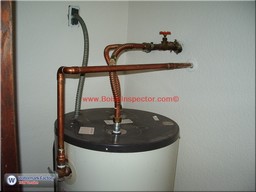 30. The discharge pipe from the pressure relief valve has been incorrectly plumbed uphill.
30. The discharge pipe from the pressure relief valve has been incorrectly plumbed uphill.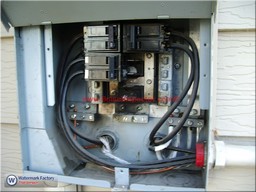 33. Scorching inside of an electrical panel
33. Scorching inside of an electrical panel

 NACHI CPI
#18092023
NACHI CPI
#18092023
 #244451
#244451

